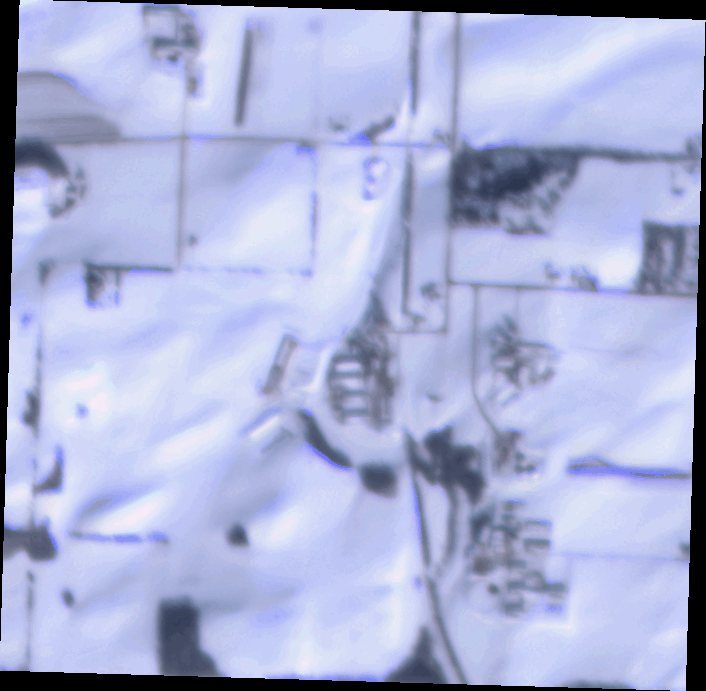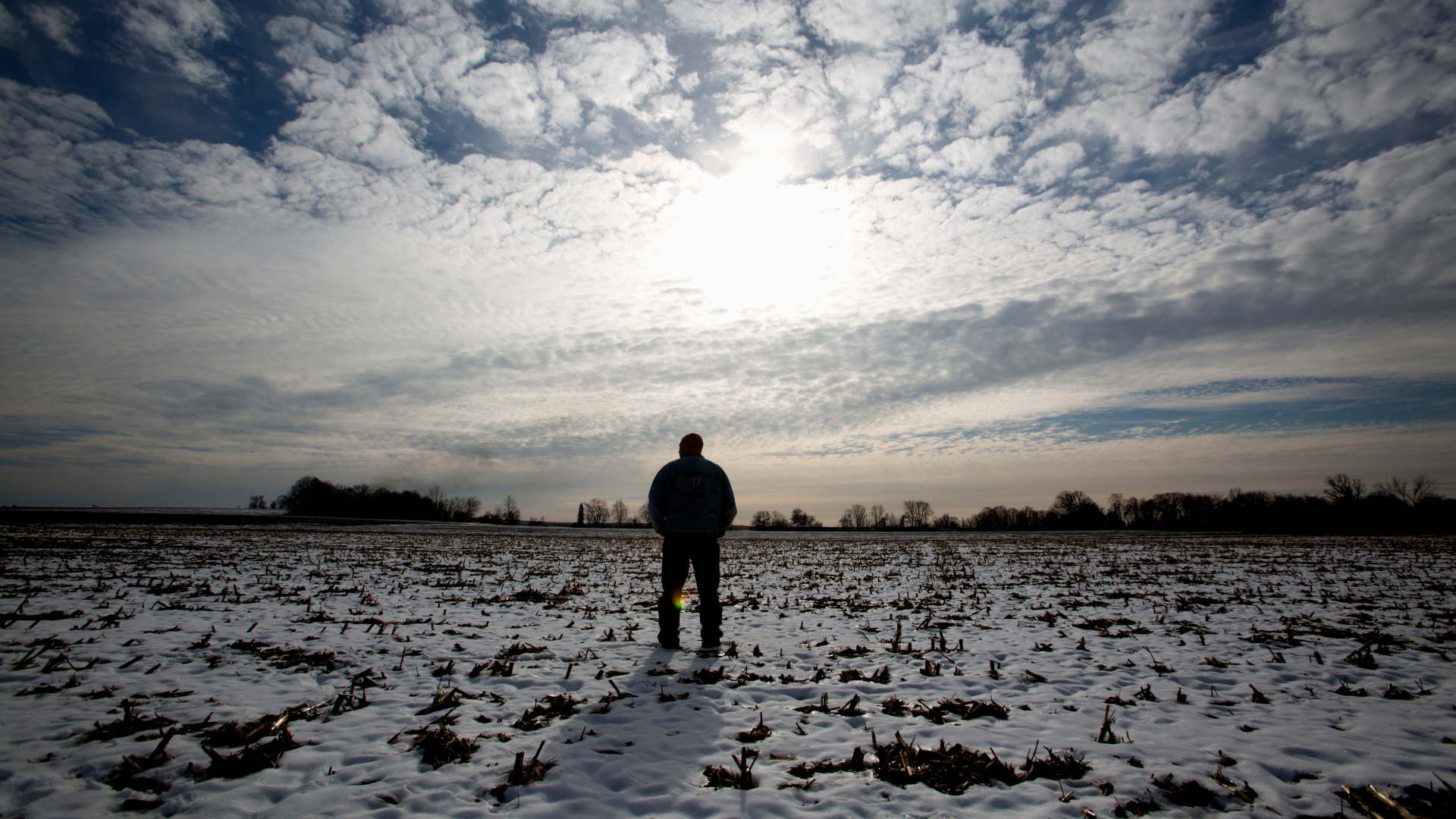In Wisconsin, Satellites Spotlight Illegal Manure Spreading
After a fresh February snow, a satellite about the size of a shoebox, busy snapping photographs as it circuited the planet at 17,000 miles per hour, captured something dark in Wisconsin.
About 56 tons of livestock bedding and manure had been spread atop Mark Zinke’s frozen alfalfa field.
The image eventually appeared on the computers of Stanford University researchers, who relayed it to the Wisconsin Department of Natural Resources.
Zinke, a Brownsville dairy farmer who cares for a herd of more than 1,300 cows, had forgotten about the whole thing until he later heard from the agency.
“Oh s—,” he recalled thinking at the time. “I guess we f—ed up. We gotta man up to it, right?”
Imagery collected by inexpensive satellites is ushering in an era of real-time monitoring. Some environmental advocates want the department to look down from the sky as it regulates livestock manure, a potential water contamination source.
Scientists from Stanford’s Regulation, Evaluation and Governance Lab are analyzing troves of aerial photographs to teach computers to recognize when farmers butter the land with livestock poop during the winter, a largely restricted but suspectedly pervasive practice in America’s Dairyland.
The research relies upon machine learning, an artificial intelligence process in which computers identify patterns to make predictions and decisions, and constellations of commercial satellites that scan Earth’s surface daily. The orbiters photographed the large farms — known as concentrated animal feeding operations, or CAFOs — during snowy Wisconsin winters. Policymakers consider a livestock farm a CAFO if it houses at least 1,000 “animal units,” the equivalent of 714 dairy cows or 2,500 pigs.
Typically, the ground is frozen or snow-covered for 100 to 140 days each Wisconsin winter. Applying manure atop it heightens the risk of runoff, which can contaminate water, spread pathogens, seed algae blooms, and kill fish.
Some environmental advocates want the state to look down from the sky as it regulates livestock manure, a potential water contamination source.
The department generally curbs CAFO manure application during winter and prohibits the practice outright in February and March unless operators obtain an exemption.
Wisconsin often relies upon citizen watchfulness and self-reporting to protect the environment from illegal spreading, but fields are not always visible from roadsides. Meanwhile, state agencies with limited staff time must prioritize enforcement.
The scientists propose bolstering regulators’ efforts to monitor large livestock farms using satellite imagery and AI — tools that could, advocates hope, be used in any snowy state.
Scientists have used satellites and machine learning to identify CAFOs in North Carolina, trace the expansion of livestock farms in Indiana, and map cropland in Wisconsin.
Previous inquiries haven’t scrutinized livestock farms in near-real time.
RegLab researchers in a 2022 study obtained images of 330 CAFO locations across Wisconsin from Planet, a San Francisco-based company that uses a fleet of more than 150 orbiters to photograph Earth’s entire land mass. Anyone with an annual subscription — starting at $10,000 — can track thousands of acres.
The Stanford scientists used near-daily images from three recent winter seasons — when manure stands out against the backdrop of snow-covered fields — to train their model to recognize spreading. The scientists also sought to identify farms that spread more frequently than others.
Later, the researchers selected a random sample of 30 winter manure-spreading events the model detected. They discovered state filings documented only four, raising questions about the comprehensiveness of the Wisconsin Department of Natural Resource’s record-keeping.
Finally, the model predicted about 700 to 1,200 instances of manure spreading during February and March 2022 when it is “presumptively prohibited.”
“The number itself is not super concrete,” RegLab data scientist Nic Rothbacher said of the estimate. “Still, I agree the conclusion is right, that there is a lot more manure application happening than perhaps the state would like to see based on environmental risk.”

In 2023, the RegLab researchers conducted a new assessment of the model’s accuracy by comparing it to a season of on-the-ground observations.
They forwarded to the Department of Natural Resources a batch of 582 potential detections captured by satellites during the two prohibited months.
From hundreds of miles above, manure streaks resemble skid marks on Mother Nature’s toilet paper, but not everything that is dark is manure.
The winter spreading of waste feed and tillage — both legal — duped the model, according to a spreadsheet of outcomes obtained through a public records request. So did solar panels. In some cases, snow melted, revealing manure from previous months.
DNR employee Ben Uvaas sifted out about 75 percent of the detections. Other staff contacted farmers, reviewed CAFO records, and inspected fields.
Their inquiries unearthed 30 instances of manure spreading during February and March, nine of which were deemed noncompliant. A handful of applications were performed legally because the manure originated at a non-CAFO; unlike CAFOs, smaller livestock farms generally are exempt from winter spreading rules.
Staff did not determine whether illegal spreading transpired in an additional 22 cases.
“We definitely did find more noncompliant winter spreading than a normal or an average year,” Uvaas said, pinning a typical figure at two or three. “That wasn’t surprising to me, considering the amount of time staff spent looking for them.”
“I just don’t think the juice is worth the squeeze to pursue this kind of technology for winter spreading issues.”
The 2022 RegLab study cannot be compared side-by-side to the latest outcomes because the researchers analyzed different things using different methods. But Uvaas thinks the new observations indicate unreported winter spreading happens in Wisconsin far less frequently than the researchers previously suggested.
He is glad the department participated; employees learned “valuable lessons,” such as the need to clarify frozen manure regulations.
Yet, for all the effort staff put into the project, Uvaas said, “I just don’t think the juice is worth the squeeze to pursue this kind of technology for winter spreading issues.”
The researchers had a different take. They considered the model’s ability to detect manure without respect to legality. It correctly spotted it in about half of the 121 cases the regulators investigated.
Broadly speaking, the greatest barrier to accuracy is a dearth of winter manure-spreading images with which to train the model. Another obstacle: Light from reflective snow cover occasionally bleached the already low-resolution images. Clouds obscured the view.
Given the uncertainties, the RegLab researchers believe authorities should use detections to prioritize cases worthy of human investigation.
Agency staff informed at least some of the farmers who spread illegally that their complaints came from eyes in the sky.
Brad Krueger didn’t know about the aerial imaging.
He milks about 770 cows at MAM Farms in Markesan, Wisconsin. In February 2023, an employee spread manure when he wasn’t supposed to, and satellites caught the results on camera.
Krueger said the knowledge that satellites could be watching wouldn’t necessarily change the way he operates. “What’s right is right, and what’s wrong is wrong,” he said.
But Krueger would prefer that a human verify all detections, a point on which he, Uvaas and the RegLab researchers agree.
“I have a problem with people sitting in an office and telling me what I should or should not do either,” Krueger adds. “Because they’re not out here, 14 degrees below zero, trying to take care of animals.”
Krueger, like several farmers, said his “beef” lies more with the fairness of Wisconsin’s manure-spreading rules than the technology with which it enforces them. Some producers say it’s unfair to single out CAFOs when operators of smaller farms can apply manure with seeming impunity.
The model’s spotting of at least 21 verified instances of permitted application during the prohibited months raises a question about the logic of state rules. Should Wisconsin lawmakers delineate legal and illegal spreading based on farm size and timing if the potential harms are the same?
The Chicago-based Environmental Law & Policy Center, which assisted RegLab in the research, calls the law arbitrary.
“The water doesn’t know or care where the poo came from,” staff attorney Katie Garvey said.
Don Weiss, of Weiss Family Farms in Durand, feels ambivalent about satellite surveillance. A Department of Natural Resources employee contacted Weiss in February 2023 after his dairy operation spread solid manure on a field the week prior.
“If they want to take a picture of my field, I ain’t got nothing to hide.”
Aerial imaging seems like a violation of his privacy, Weiss said, but farmers also must comply with regulations. “It’s such a gray area that it’s so hard to tell what is the right or wrong thing to do,” he said. “I know they need to monitor people because people try to get away with murder.”
Stanford researchers have likewise pondered privacy implications. The initial RegLab study noted that CAFO operators already must report spreading. State and federal officials could arrive at any time to inspect a farm, and operations often sit in public view.
Zinke, the Brownsville farmer, laughs about his encounter with satellites. He resigns himself to scrutiny. If not a satellite, he said, something else would watch — perhaps a trespassing neighbor on a four-wheeler.
“If they want to take a picture of my field,” Zinke said, “I ain’t got nothing to hide.”
Bennet Goldstein reports on water and agriculture as Wisconsin Watch’s Report for America representative on the Mississippi River Basin Ag & Water Desk.
This story is a product of the Mississippi River Basin Ag & Water Desk, an independent reporting network based at the University of Missouri in partnership with Report for America, with major funding from the Walton Family Foundation. Sign up to republish stories like this one for free.












Please continue with these Truthful Articles